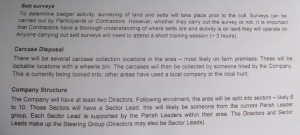From our friends at the Gloucestershire Badger Office:
As the foxhunting season starts to draw to a close, groups are beginning to focus more time on sett-surveying, sett-checking and preparing for the expected further roll-out this year. Many lessons have been learned over the last 4 years and we will continue to learn and adapt our tactics in order to target culling and other forms of wildlife persecution.
Whatever happens in the ‘original’ Gloucestershire cull zone, Gloucestershire Badger Office intends to keep fighting within the ‘northern zones’ and to give advice and support to zones further afield. We received leaked documents some time ago regarding a potential new zone that would become active this year and locals in the area are working hard on researching and preparing for the cull in that area. We will let them announce it when they’re ready to…
In the meantime, we wanted to share parts of the documents received to reiterate a few of the things we spotted over the last few years. For example, much like our own work, someone will be centrally plotting setts on maps for the zone.
The NFU will still be around to assist but the main body of work is to be done locally. For example, sett-surveying is to be done by the landowners themselves (or those they have nominated) – setts are to be marked on maps using red crosses and the training session which must be completed prior to sett-surveying the land will be around 2 hours long.
The first year of culling in Gloucestershire saw a huge number of new vehicles and shooters coming in from other areas as contractors. Over the following 2 years we saw far fewer ‘outsiders’ being brought in. From year 2 onwards we were aware that much more of the actual culling work was being done by locals, landowners and their friends themselves. This is the case for new zones as lessons have been learned from the original pilot areas… landowners themselves will be their own contractors, trapping and shooting or ‘free-shooting’ badgers themselves. They can also nominate someone to act as a contractor for them, for example if they do not have the required firearms licence. Of course, this allows for a contractor to work for more than one landowner, potentially then working in more than one zone. We believed this would happen in the ‘northern zones’ (Glos, North Cots, Here) which was later confirmed as being the case with some contractors and it may be seen in other areas where different zones are close together.
Cage-trapping is encouraged as “it is discrete and effective” – another ‘lesson learned’ from original zones.
If land is rented and has a tenancy of less than 4 years, the landlord must countersign in order for culling to take place on that land. However, if the tenancy is longer than 4 years the landlord does not have to countersign for it.
Other notes:
– 70% enrolment is still required in each area (i.e. 70% of the land considered ‘the zone’ must be signed up to the cull)
– each participant must be signed up for a 4-year commitment
– as in the current cull zones, there will be several disposal areas for bodies – mainly farms, but local hunts may also be used*
*considering the recent news of the Kimblewick hunt hounds contracting tb and given the number of breaches of cull guidelines by contractors observed in the various cull zones over the last few years surely this should be reconsidered
Watch this space for more information and for our upcoming ‘local groups advice’. With roll-out spreading further we believe that local-led initiatives against wider wildlife persecution is going to be the way forward. More on that soon…
GBO



